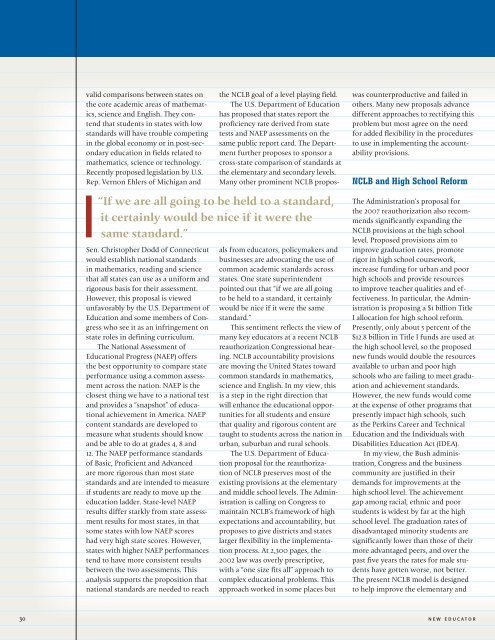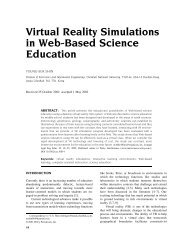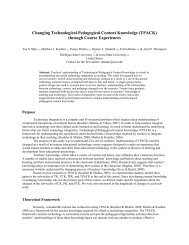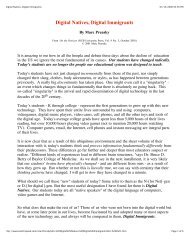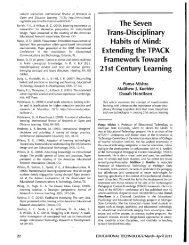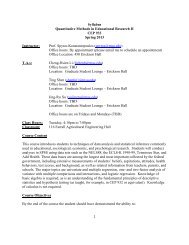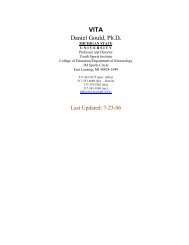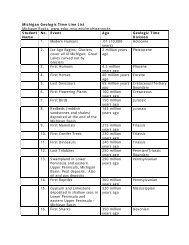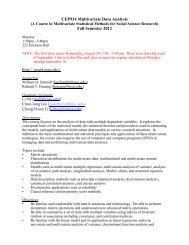Spring 2007 - College of Education - Michigan State University
Spring 2007 - College of Education - Michigan State University
Spring 2007 - College of Education - Michigan State University
You also want an ePaper? Increase the reach of your titles
YUMPU automatically turns print PDFs into web optimized ePapers that Google loves.
valid comparisons between states on<br />
the core academic areas <strong>of</strong> mathematics,<br />
science and English. They contend<br />
that students in states with low<br />
standards will have trouble competing<br />
in the global economy or in post-secondary<br />
education in fields related to<br />
mathematics, science or technology.<br />
Recently proposed legislation by U.S.<br />
Rep. Vernon Ehlers <strong>of</strong> <strong>Michigan</strong> and<br />
Sen. Christopher Dodd <strong>of</strong> Connecticut<br />
would establish national standards<br />
in mathematics, reading and science<br />
that all states can use as a uniform and<br />
rigorous basis for their assessment.<br />
However, this proposal is viewed<br />
unfavorably by the U.S. Department <strong>of</strong><br />
<strong>Education</strong> and some members <strong>of</strong> Congress<br />
who see it as an infringement on<br />
state roles in defining curriculum.<br />
The National Assessment <strong>of</strong><br />
<strong>Education</strong>al Progress (NAEP) <strong>of</strong>fers<br />
the best opportunity to compare state<br />
performance using a common assessment<br />
across the nation. NAEP is the<br />
closest thing we have to a national test<br />
and provides a “snapshot” <strong>of</strong> educational<br />
achievement in America. NAEP<br />
content standards are developed to<br />
measure what students should know<br />
and be able to do at grades 4, 8 and<br />
12. The NAEP performance standards<br />
<strong>of</strong> Basic, Pr<strong>of</strong>icient and Advanced<br />
are more rigorous than most state<br />
standards and are intended to measure<br />
if students are ready to move up the<br />
education ladder. <strong>State</strong>-level NAEP<br />
results differ starkly from state assessment<br />
results for most states, in that<br />
some states with low NAEP scores<br />
had very high state scores. However,<br />
states with higher NAEP performances<br />
tend to have more consistent results<br />
between the two assessments. This<br />
analysis supports the proposition that<br />
national standards are needed to reach<br />
“If we are all going to be held to a standard,<br />
it certainly would be nice if it were the<br />
same standard.”<br />
the NCLB goal <strong>of</strong> a level playing field.<br />
The U.S. Department <strong>of</strong> <strong>Education</strong><br />
has proposed that states report the<br />
pr<strong>of</strong>iciency rate derived from state<br />
tests and NAEP assessments on the<br />
same public report card. The Department<br />
further proposes to sponsor a<br />
cross-state comparison <strong>of</strong> standards at<br />
the elementary and secondary levels.<br />
Many other prominent NCLB proposals<br />
from educators, policymakers and<br />
businesses are advocating the use <strong>of</strong><br />
common academic standards across<br />
states. One state superintendent<br />
pointed out that “if we are all going<br />
to be held to a standard, it certainly<br />
would be nice if it were the same<br />
standard.”<br />
This sentiment reflects the view <strong>of</strong><br />
many key educators at a recent NCLB<br />
reauthorization Congressional hearing.<br />
NCLB accountability provisions<br />
are moving the United <strong>State</strong>s toward<br />
common standards in mathematics,<br />
science and English. In my view, this<br />
is a step in the right direction that<br />
will enhance the educational opportunities<br />
for all students and ensure<br />
that quality and rigorous content are<br />
taught to students across the nation in<br />
urban, suburban and rural schools.<br />
The U.S. Department <strong>of</strong> <strong>Education</strong><br />
proposal for the reauthorization<br />
<strong>of</strong> NCLB preserves most <strong>of</strong> the<br />
existing provisions at the elementary<br />
and middle school levels. The Administration<br />
is calling on Congress to<br />
maintain NCLB’s framework <strong>of</strong> high<br />
expectations and accountability, but<br />
proposes to give districts and states<br />
larger flexibility in the implementation<br />
process. At 2,300 pages, the<br />
2002 law was overly prescriptive,<br />
with a “one size fits all” approach to<br />
complex educational problems. This<br />
approach worked in some places but<br />
was counterproductive and failed in<br />
others. Many new proposals advance<br />
different approaches to rectifying this<br />
problem but most agree on the need<br />
for added flexibility in the procedures<br />
to use in implementing the accountability<br />
provisions.<br />
NCLB and High School Reform<br />
The Administration’s proposal for<br />
the <strong>2007</strong> reauthorization also recommends<br />
significantly expanding the<br />
NCLB provisions at the high school<br />
level. Proposed provisions aim to<br />
improve graduation rates, promote<br />
rigor in high school coursework,<br />
increase funding for urban and poor<br />
high schools and provide resources<br />
to improve teacher qualities and effectiveness.<br />
In particular, the Administration<br />
is proposing a $1 billion Title<br />
I allocation for high school reform.<br />
Presently, only about 5 percent <strong>of</strong> the<br />
$12.8 billion in Title I funds are used at<br />
the high school level, so the proposed<br />
new funds would double the resources<br />
available to urban and poor high<br />
schools who are failing to meet graduation<br />
and achievement standards.<br />
However, the new funds would come<br />
at the expense <strong>of</strong> other programs that<br />
presently impact high schools, such<br />
as the Perkins Career and Technical<br />
<strong>Education</strong> and the Individuals with<br />
Disabilities <strong>Education</strong> Act (IDEA).<br />
In my view, the Bush administration,<br />
Congress and the business<br />
community are justified in their<br />
demands for improvements at the<br />
high school level. The achievement<br />
gap among racial, ethnic and poor<br />
students is widest by far at the high<br />
school level. The graduation rates <strong>of</strong><br />
disadvantaged minority students are<br />
significantly lower than those <strong>of</strong> their<br />
more advantaged peers, and over the<br />
past five years the rates for male students<br />
have gotten worse, not better.<br />
The present NCLB model is designed<br />
to help improve the elementary and<br />
30<br />
new educator


